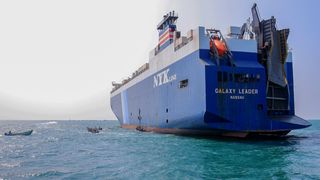For the past decade, analysts have repeatedly asserted the importance of the Indian Ocean to the defence and security of the broader Indo-Pacific region.
The Indian Ocean is now the globe’s busiest and most strategically significant trade corridor, carrying two-thirds of the world’s oil shipments and a third of the world’s bulk cargo. The vulnerability of the global commons has been on display since late 2023 as Houthi rebels in Yemen have attacked shipping in the Red Sea and the Gulf of Aden. The rebels claimed to be targeting ships based on their links to the United States or Israel to support Palestinians in the Israel-Hamas conflict.
These attacks significantly disrupted international trade as the Red Sea, via the Suez Canal, offers the shortest shipping route between Asia and Europe. The response, led by the United States, saw an international coalition formed to ensure freedom of the seas as well as tailored strikes in Yemen and the seizure of a container ship with Iranian-supplied weapons bound for the Houthis.
Securing this vital choke point from such asymmetric challenges highlights the difficulties even powerful actors face when protecting sea lines of commerce and communication across the Indian Ocean. It also means an enhanced role for trade-dependent regional powers, which depend on freedom of navigation and a rules-based order for their sovereignty and prosperity.
A November 2023 workshop at the East-West Center looked specifically at the role of one such regional power — Australia, a staunch treaty ally of the United States. With the longest Indian Ocean coastline of any country, Australia is developing its Indian Ocean security assets — including the joint US-UK Submarine Rotational Force-West (SRF-West), offering a nuclear submarine presence at HMAS Stirling near Perth, the capital of Western Australia, as early as 2027.This step represents perhaps the most tangible example of Australia’s move from an “Asia-Pacific” geostrategic view of the region to an “Indo-Pacific” one.
Australia was the first country to apply the Indo-Pacific concept strategically, with the 2013 Defence White Paper identifying “a new Indo-Pacific strategic arc” connecting the Indian and Pacific oceans through Southeast Asia. Another Asia-Pacific Bulletin noted that “Australia is particularly sensitive to threats or potential threats to critical shipping lanes to [its] north and northwest. Hence, Australia’s enthusiasm for a nuclear-propelled conventionally armed submarine fleet.”Thus, Australian strategists are increasingly focused on threats to vital eastern Indian Ocean shipping lanes through which most of its trade travels.
For the United States, however, the “Indo” part of the US Indo-Pacific strategy is less about the Indian Ocean and more squarely aimed at India. The US calculation is that drawing India, now the world’s largest country by population, into a closer partnership helps deter would-be aggressors (read China) and help maintain a regional balance of power. Military and industrial co-production in the field of fighter jet engines, ship repair, and technology transfer are all part of this new cooperation. For Australia, too, relations with India have hit a new high point, with much closer naval cooperation and military exchanges than ever before. But there is a sting in the tail: India’s transition from the non-aligned movement, the uncertain trajectory of Indian democracy, and, at times, divergent interests with the United States means there are limits to the pace, depth, and breadth of such security cooperation.
Additionally, US interest in the Indian Ocean will always be secondary to its responsibilities in the Pacific, especially Northeast Asia. This means the United States is looking for allies like Australia to play a more prominent role in safeguarding the Indian Ocean commons. The AUKUS announcement of SRF-West, which will include one Astute class submarine from the United Kingdom and up to four US Virginia-class submarines, is part of this expanding role. The announced upgrades of the currently vestigial Curtin and Learmonth air force bases — both in northwest Western Australia — are another. A more substantial defence presence in Australia’s eastern Indian Ocean outposts, such as Christmas and Cocos (Keeling) Islands, stands as a longer-term goal.
In the meantime, ongoing disruptions in the Gulf of Aden and the vulnerability of other key Indian Ocean bottlenecks in the straits of Hormuz or Malacca reinforce the need to maintain a rules-based order and the free flow of goods on our maritime superhighways. It also highlights an inconvenient truth: the country with the most to lose from a disruption of the Indian Ocean today is China, which relies overwhelmingly on Middle East oil to run its economy. In recent years, China has increased its Indian Ocean naval rotations and today maintains three to eight warships in the Indian Ocean region at any given time. Sustained investments in the Indian Ocean ports in recent years have seen Beijing secure a 99-year lease over the Sri Lankan port of Hambantota, on the busy shipping lane between Asia and the West, as well as Darwin Port in Australia’s Northern Territory. The People’s Liberation Army Navy also has a long-standing anti-piracy operation off Somalia since 2008, with the Red Sea a key part of China’s 21st century Maritime Silk Road.
As Houthi leadership granted safe passage to Chinese and Russian ships with no links to Israel, the risk to the more than 1,200 Chinese merchant ships passing through the Gulf of Aden annually — accounting for 40 per cent of all goods and raw materials shipped to China — has been substantially reduced. Thus, the PRC has largely stood by passively in response to this brazen threat to international shipping. Similarly, the PRC’s muted calls for de-escalation have been reinforced by its abstention from the UN Security Council’s resolutions on the Houthi attacks.
China’s response indicates a willingness to free-ride on US efforts to mobilise partners and allies to secure vital sea lanes. In the Red Sea case, the US mobilisation included UK and French warships, Indian Ocean treaty allies such as Australia, and newer partners from the region. This assemblage highlights the reality that cooperation at both the mini-lateral and multilateral levels is needed to ensure Indian Ocean security, particularly given the demands of ongoing hot wars in Ukraine and Israel-Palestine. Both the United States, via its convening soft power, as well as allies such as Australia and other like-minded partners, need to find ways of accelerating such cooperation to maximise increasingly far-stretched hard power resources.







